2011 HONDA CR-V seats
[x] Cancel search: seatsPage 35 of 445

There will be some delay between
the moment the passenger moves
into or out of the airbag deployment
pathandwhentheindicatorcomes
on or goes of f .
A f ront seat passenger should not
use a cushion or another object as a
backrest. It may prevent the cutof f
system f rom working properly.
Only one airbag will deploy during a
side impact. If the impact is on the
passenger’s side, the passenger’s
side airbag will deploy even if there
is no passenger.
To get the best protection f rom the
side airbags, front seat occupants
should wear their seat belts and sit
upright and well back in their seats.
If the side airbag of f indicator comes
on (see page ), have the
passenger sit upright. Once the
passenger is out of the airbag’s
deployment path, the system will
turn the airbag back on, and the
indicator will go out.
Your vehicle has a side airbag cutof f
system designed primarily to protect
a child riding in the f ront passenger’s
seat.
Although Honda does not encourage
children to ride in f ront, if the
position sensors detect a child has
leaned into the side airbag’s
deployment path, the airbag will shut
off.
Thesideairbagmayalsoshutoff if a
short adult leans sideways, or a
larger adult slouches and leans
sideways into the airbag’s
deployment path.
Objects placed on the f ront
passenger seat can also cause the
side airbag to be shut of f . 32
Side A irbag Cut of f Syst em
Additional Inf ormation About Your Airbags
30
Main MenuTable of Contents
Page 36 of 445

If the impact is on the passenger’s
side, the passenger’s side curtain
airbag will inf late even if there are no
occupants on that side of the vehicle.To get the best protection f rom the
side curtain airbags, occupants
should wear their seat belts and sit
upright and well back in their seats.
In a moderate to severe side impact,
sensors will detect rapid acceleration
and signal the control unit to
instantly inflate the side curtain
airbag. If the rollover sensor detects your
vehicle is about to roll over, it signals
the control unit, which immediately
deploys both side curtain airbags.
The airbag on the passenger’s side
will deploy, even if there are no
passengers on that side of the
vehicle.
How Your Side Curtain A irbags
Work
In a Side Impact
In a Rollover
Additional Inf ormation About Your Airbags
Driver and Passenger Saf ety
31
SIDE CURTAIN AIRBAG
Main MenuTable of Contents
Page 45 of 445
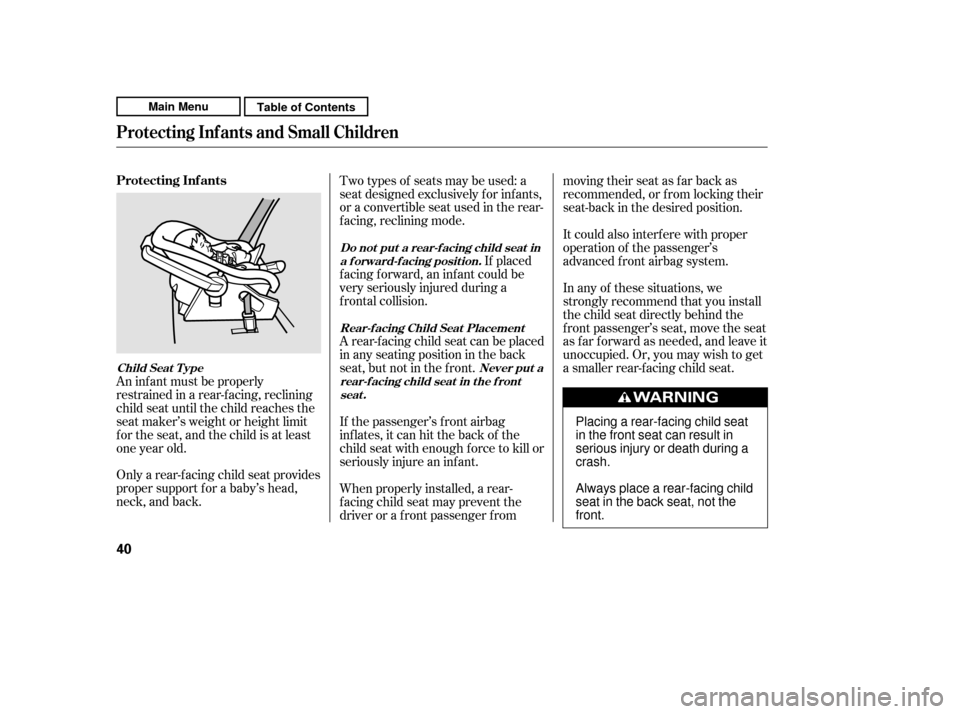
Only a rear-f acing child seat provides
proper support f or a baby’s head,
neck, and back.
An inf ant must be properly
restrained in a rear-f acing, reclining
child seat until the child reaches the
seat maker’s weight or height limit
f or the seat, and the child is at least
one year old. Two types of seats may be used: a
seat designed exclusively f or inf ants,
or a convertible seat used in the rear-
f acing, reclining mode.
If placed
f acing f orward, an inf ant could be
very seriously injured during a
f rontal collision.
A rear-f acing child seat can be placed
in any seating position in the back
seat, but not in the f ront.
If the passenger’s front airbag
inflates, it can hit the back of the
child seat with enough f orce to kill or
seriously injure an inf ant.
When properly installed, a rear-
f acing child seat may prevent the
driver or a f ront passenger f rom moving their seat as far back as
recommended, or f rom locking their
seat-back in the desired position.
It could also interf ere with proper
operation of the passenger’s
advanced front airbag system.
In any of these situations, we
strongly recommend that you install
the child seat directly behind the
f ront passenger’s seat, move the seat
as far forward as needed, and leave it
unoccupied. Or, you may wish to get
a smaller rear-f acing child seat.
Do not put a rear-f acing child seat in
a f orward-f acing position.
Child Seat T ype Rear-f acing Child Seat Placement
Never put a
rear-f acing child seat in t he f ront
seat .
Protecting Inf ants
Protecting Inf ants and Small Children
40
Placing a rear-facing child seat
in the front seat can result in
serious injury or death during a
crash.
Always place a rear-facing child
seat in the back seat, not thefront.
Main MenuTable of Contents
Page 46 of 445
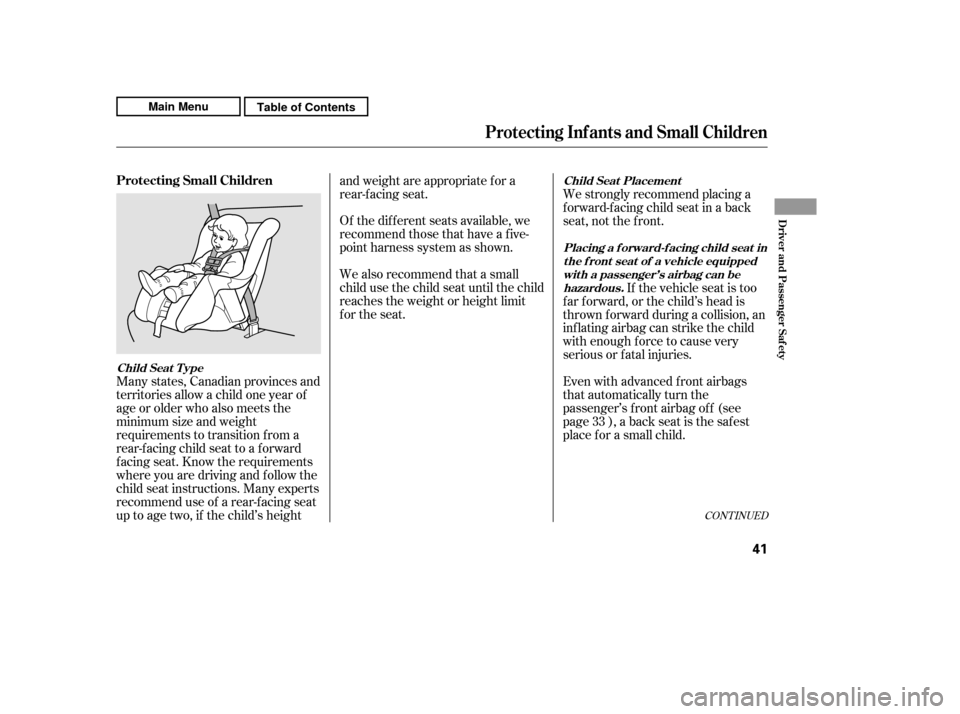
CONT INUED
Many states, Canadian provinces and
territories allow a child one year of
age or older who also meets the
minimum size and weight
requirements to transition f rom a
rear-f acing child seat to a f orward
f acing seat. Know the requirements
where you are driving and f ollow the
child seat instructions. Many experts
recommend use of a rear-f acing seat
up to age two, if the child’s heightand weight are appropriate f or a
rear-f acing seat.
Of the different seats available, we
recommend those that have a f ive-
point harness system as shown.
We also recommend that a small
child use the child seat until the child
reaches the weight or height limit
for the seat.
We strongly recommend placing a
forward-facing child seat in a back
seat, not the f ront.
Even with advanced front airbags
that automatically turn the
passenger’s front airbag off (see
page ), a back seat is the saf est
place f or a small child.If the vehicle seat is too
f ar f orward, or the child’s head is
thrown f orward during a collision, an
inf lating airbag can strike the child
with enough f orce to cause very
serious or f atal injuries.
33
Protecting Inf ants and Small Children
Protecting Small Children
Child Seat T ype Child Seat Placement
Placing a f orward-f acing child seat int he f ront seat of a vehicle equipped
with a passenger’s airbag can behazardous.
Driver and Passenger Saf ety
41
Main MenuTable of Contents
Page 47 of 445
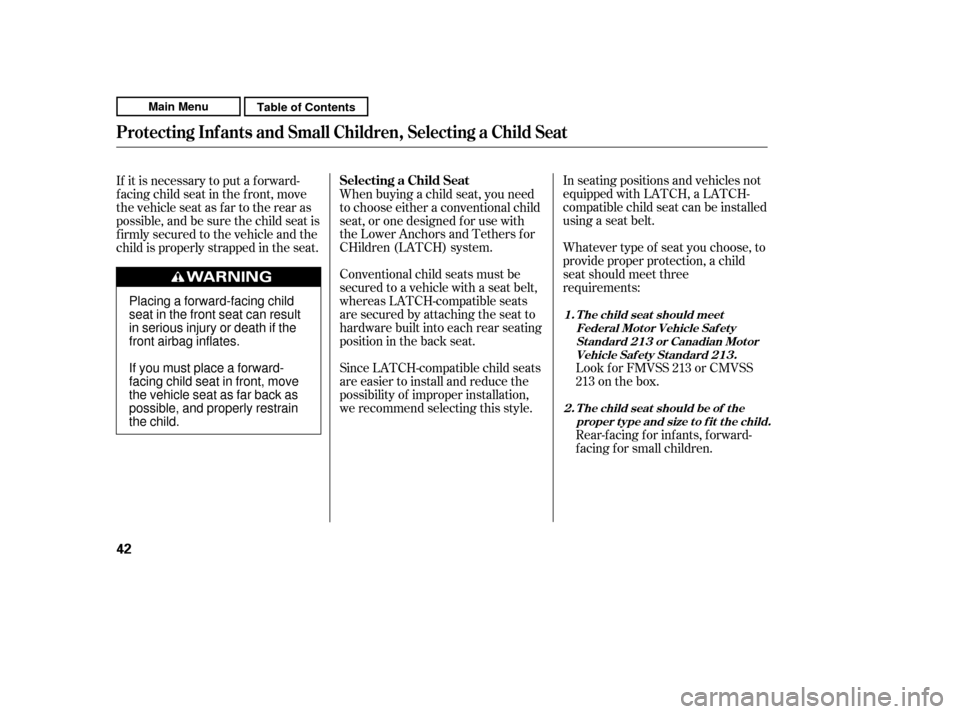
In seating positions and vehicles not
equipped with LATCH, a LATCH-
compatible child seat can be installed
using a seat belt.
Whatever type of seat you choose, to
provide proper protection, a child
seat should meet three
requirements:Look f or FMVSS 213 or CMVSS
213 on the box.
Since LATCH-compatible child seats
are easier to install and reduce the
possibility of improper installation,
we recommend selecting this style.
When buying a child seat, you need
to choose either a conventional child
seat, or one designed f or use with
the Lower Anchors and Tethers f or
CHildren (LATCH) system.
Conventional child seats must be
secured to a vehicle with a seat belt,
whereas LATCH-compatible seats
are secured by attaching the seat to
hardware built into each rear seating
position in the back seat.
Rear-facing for infants, forward-
f acing f or small children.
If it is necessary to put a f orward-
f acing child seat in the f ront, move
the vehicle seat as far to the rear as
possible, and be sure the child seat is
f irmly secured to the vehicle and the
child is properly strapped in the seat.
T he child seat should meet
Federal Mot or Vehicle Saf et ySt andard 213 or Canadian Mot or
Vehicle Saf et y St andard 213.
T he child seat should be of theproper t ype and size t o f it t he child.
1.
2.
Selecting a Child Seat
Protecting Inf ants and Small Children, Selecting a Child Seat
42
Placing a forward-facing child
seat in the front seat can result
in serious injury or death if the
front airbag inflates.
Ifyoumustplaceaforward-
facing child seat in front, move
the vehicle seat as far back as
possible, and properly restrain
the child.
Main MenuTable of Contents
Page 48 of 445
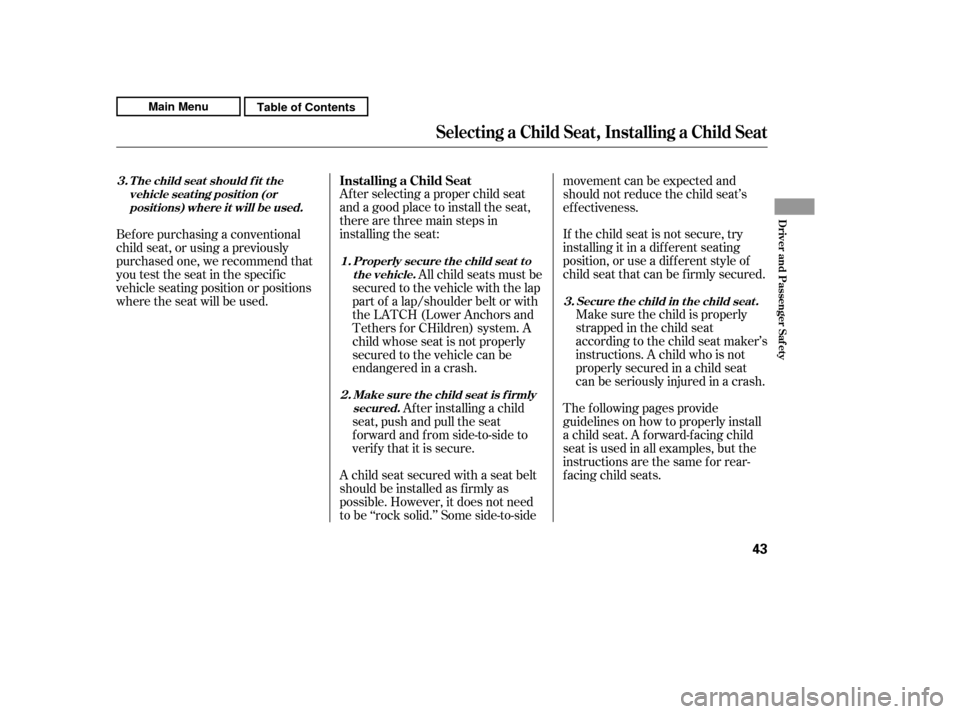
Af ter selecting a proper child seat
and a good place to install the seat,
there are three main steps in
installing the seat:Af ter installing a child
seat, push and pull the seat
f orward and f rom side-to-side to
verif y that it is secure.
A child seat secured with a seat belt
should be installed as f irmly as
possible. However, it does not need
to be ‘‘rock solid.’’ Some side-to-side movement can be expected and
should not reduce the child seat’s
ef f ectiveness.
If the child seat is not secure, try
installing it in a dif f erent seating
position, or use a dif f erent style of
child seat that can be f irmly secured.
Make sure the child is properly
strappedinthechildseat
according to the child seat maker’s
instructions. A child who is not
properly secured in a child seat
can be seriously injured in a crash.
The f ollowing pages provide
guidelines on how to properly install
a child seat. A f orward-f acing child
seat is used in all examples, but the
instructions are the same f or rear-
f acing child seats.
All child seats must be
secured to the vehicle with the lap
part of a lap/shoulder belt or with
the LATCH (Lower Anchors and
Tethers f or CHildren) system. A
child whose seat is not properly
secured to the vehicle can be
endangered in a crash.
Bef ore purchasing a conventional
child seat, or using a previously
purchased one, we recommend that
you test the seat in the specif ic
vehicle seating position or positions
where the seat will be used.
Installing a Child Seat
Make sure t he child seat is f irmly
secured. Secure t he child in t he child seat .
Properly secure t he child seat t o
the vehicle.
T he child seat should f it the
vehicle seat ing posit ion (or posit ions) where it will be used.
3.
1.
2. 3.
Selecting a Child Seat, Installing a Child Seat
Driver and Passenger Saf ety
43
Main MenuTable of Contents
Page 49 of 445
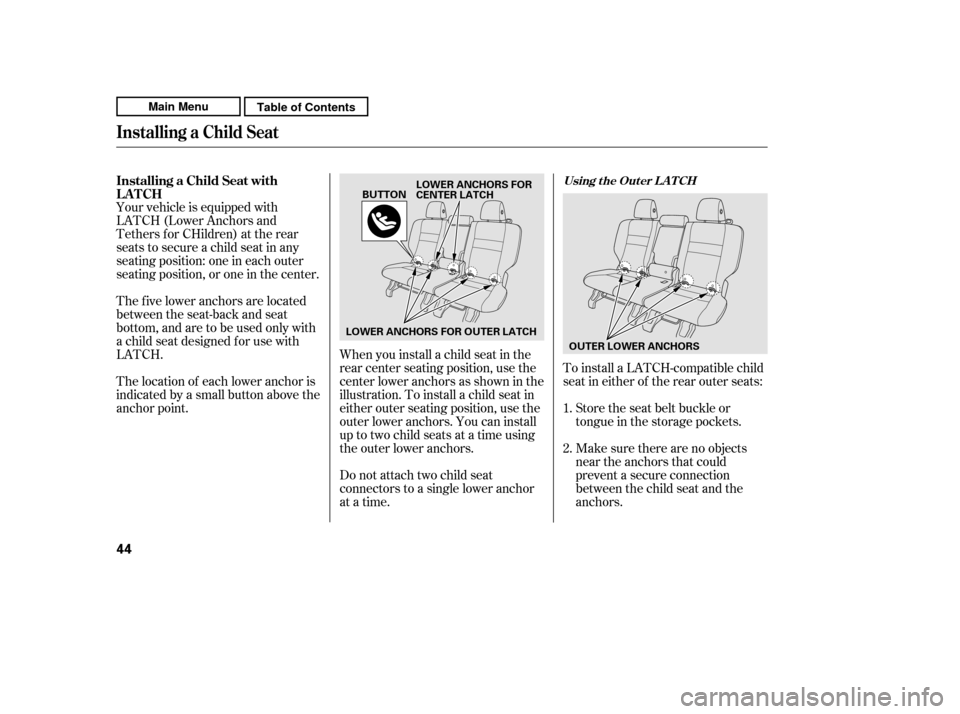
Your vehicle is equipped with
LATCH (Lower Anchors and
Tethers f or CHildren) at the rear
seats to secure a child seat in any
seating position: one in each outer
seating position, or one in the center.
Thefiveloweranchorsarelocated
between the seat-back and seat
bottom, and are to be used only with
a child seat designed f or use with
LATCH.
The location of each lower anchor is
indicated by a small button above the
anchor point.When you install a child seat in the
rear center seating position, use the
center lower anchors as shown in the
illustration. To install a child seat in
either outer seating position, use the
outer lower anchors. You can install
up to two child seats at a time using
the outer lower anchors.
Do not attach two child seat
connectors to a single lower anchor
at a time.
Make sure there are no objects
near the anchors that could
prevent a secure connection
between the child seat and the
anchors.
Store the seat belt buckle or
tongue in the storage pockets.
To install a LATCH-compatible child
seat in either of the rear outer seats: 1. 2.
Installing a Child Seat with
LATCH
Using t he Out er L A T CH
Inst alling a Child Seat
44
LOWER ANCHORS FOR OUTER LATCH
BUTTON
LOWER ANCHORS FOR
CENTER LATCH
OUTER LOWER ANCHORS
Main MenuTable of Contents
Page 50 of 445

Place the child seat on the vehicle
seat, then attach the seat to the
lower anchors according to the
child seat maker’s instructions.
Some LATCH-compatible seats have
a rigid-type connector as shown
above. Whatever type you have, f ollow
the child seat maker’s instructions
f or adjusting or tightening the f it.
Remove the dual deck cargo shelf
(see page ).
Other LATCH-compatible seats have
a f lexible-type connector as shown
above.
Route the tether strap over the
seat-back and through the legs of
the head restraint, then attach the
tether strap hook to the anchor,
making sure the tether strap is not
twisted.
5.
4.
3.
6.
117
CONT INUED
If equipped
Inst alling a Child Seat
Driver and Passenger Saf ety
45
Flexible type
Rigid type TETHER
ANCHOR
TETHER STRAP HOOK
Main MenuTable of Contents